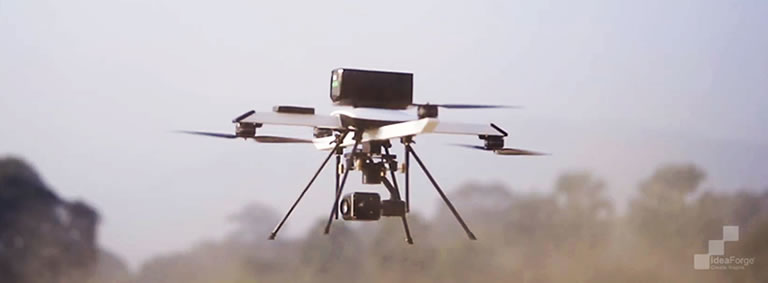We are living in pretty exciting times as we witness the fourth industrial revolution unfold right before our eyes! While the third industrial revolution was all about the rise of electronics, internet and adoption of computers in general, Industrial Revolution 4.0 will be driven by automation and cyber-physical technology that will take forward the computerization of Industrial Revolution 3.0. Leading Industrial Revolution 4.0 are drones that having delivered stellar results in defence and military applications and are now maturing into harbingers of unprecedented levels of business optimization.
Emerging out of the shadows of security and surveillance applications, drones are flourishing in several industries. Not just government organisations, but commercial entities have also realised their massive potential as they save huge number of man-hours. With substantial increase in investments by equipment suppliers, continuing funding for defence contractors, prototype systems for remotely identifying and even neutralizing drones, and vastly expanded use in mapping and surveying. First-mover organizations have already built a competitive advantage over their peers and are scaling the integration of drone technology with business processes to strengthen their market positions.
According to global market intelligence and advisory firm BIS Research, the Indian UAV market will reach $885.7 million over the next few years while the global market size will touch $21.47 billion. With 5% of the world’s UAV imports, India tops the list of drone-importing countries. The reason why the drone market has seen such rapid expansion and still holds so much potential is because drones are being increasingly utilized to improve operational efficiency in several sectors. It is increasingly evident that capital-intensive industries are staring at margin contraction and reducing costs of operation by adopting drone technology is the way forward. The capability of UAVs to provide an eye in the sky with high-resolution videos, their feasibility in providing real-time situational awareness along with evidence collecting ability, map large areas and inspect hazardous and hard-to-reach areas make them an unmatched tool for security and surveillance, law enforcement, project progress monitoring, infrastructure inspection and disaster management.
In oil and gas industry, drones provide a faster, cost effective and safer means of inspecting pipelines and allied infrastructure – something which would traditionally take weeks or months, expensive equipment, resources and manpower. This reduces shutdowns due to maintenance and can save over $5 million per day for the industry.
Aerial survey of a mining area can be used to identify environmental impact, optimize drilling and blasting, monitor loading operations and inspection of mining equipment and hard-to-reach or hazardous areas. Automated flights can be scheduled for accurate updates on stockpile volumes. It is already been seen that automation of mining processes via UAVs increased productivity at mine sites by a staggering 25%.
Drones are turning out to be a critical tool in precision agriculture. Imaging data from a drone is a good indicator of crop vigor and canopy stress. Multi-spectral sensors enable farmers to precisely apply water, fertilizers, or pesticides and get site-specific information regarding crop health, fungal infections, growth bottlenecks etc. Precision agriculture enhances farm yield significantly and also decreases the cost up to 85%.
Inspection of a solar farm using a drone equipped with thermal camera can detect faults and streamline workflows in significantly less time which can boost savings by a factor of 5 to 20. Organizations can proactively address anomalies to minimize maintenance cost and downtime by up to 95%. The use of drones for solar farm inspection can double safety rates and can halve the time taken to survey project site.
It is not just the features or applications of a drone that makes this industry so dynamic, the industry is creating a lot of job opportunities in the country. With increasing adoption of drones in several sectors, the number of certified remote pilots grown to 115,000 which is 50% more over the previous year. It is predicted that there will be 100,000 drone-related jobs set to take off over the next few years. Besides aerial photography and cinematography, job opportunities in the field of mapping and 3D modelling, AI, thermography, R&D, manufacturing, etc. are presenting several rewarding careers to job aspirants. There are opportunities in engineering, operations, sales and marketing, etc for engineers, UAV pilots, operators and managers with all levels of experience.
In order to build a safe, world-class and drone-friendly regulatory environment in India, the government has brought in Civil Aviation Requirement (CAR) that will govern the usage of drones in India. The ‘No Permission, No Takeoff’ (NPNT) standard of Drone Regulations 1.0 is a first-of-its-kind protocol that can establish India as a pioneer in implementing an all-digital process for drone registration and operation with built-in enforcement. CAR is the first step towards leveraging drone technology and heavy investments are being contemplated in this segment. This phenomenon has already led to the opening of huge opportunities by investors and enterprises adopting UAVs in the B2B market in the country which is essential to create a culture of innovation for the industry to thrive.
With each passing year, drone sales are on the rise as more industries understand the benefits of automating business processes. Already, several companies have deployed huge resources in reimagining drone technology and are continuously sketching new applications that can make drones a part of everyday life. However, it is vivid that we have barely begun to scratch the surface of this exciting technology and by the amount of hard work and investment put in by engineers and investors to surpass existing performance parameters, the best is yet to come!
(The author is Co-Chair, FICCI Committee on Drones, and Co-Founder & CEO, IdeaForge Technology Pvt Ltd)






Well written article. I feel that the need to develop counter technology to mitigate the threat arising from drones has a great future too.